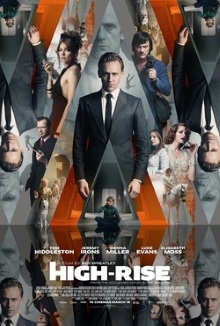
This came to my attention due to a post on Broken Forum but even the poster refrained from calling it a good film. I was further intrigued by it being an adaptation of a well-known novel by J.G. Ballard. Ballard is these days best known for his novel Empire of the Sun due to it being made into a film by Steven Spielberg but most of his literary output is actually dystopian science-fiction, a genre that High-Rise perfectly falls into.
It’s the 1970s and living in high-rise complexes is all the rage. Robert Laing moves into one of the most modern and luxurious of these towers following a personal tragedy. The building was designed to be almost completely self-contained, featuring numerous amenities such as a swimming pool, a gym, a primary school and even a supermarket. The architect himself, Anthony Royal, lives on the top floor which has been made over into an elaborate garden. At first, things go swimmingly as Laing is introduced to his new neighbors, including the single mother Charlotte Melville and the couple Richard and Helen Wilder who live on the lower floors. Laing is even taken to meet Royal himself who apparently sees the whole building as a sort of experiment. But technical problems such as power and water outages cause tensions in the building to rise while Laing himself becomes embroiled in a feud with a medical student who turns out to be one of the higher floor residents in the same building. Eventually as violence breaks out, life in the building descends into outright anarchy.
I’ve never heard about director Ben Wheatley but the presence of recognizable stars like Tom Hiddleston, Sienna Miller and Elizabeth Moss means that this is a fairly major film with suitably high production standards. The visuals are generally rather striking and it’s obvious that the director is trying hard to channel Stanley Kubrick’s A Clockwork Orange. You can see that film’s influence in everything from the colors to the scenes in which Tom Hiddleston drags a golf club behind him as he walks. This makes sense as the themes of both films mirror one another and even the era is compatible. Unfortunately, it also means that High-Rise has big shoes to fill to prevent it from being a second-rate copy of a masterpiece. By and large, it fails to do so.
The film uses the building as a microcosm of society with the poorer residents occupying the lower floors and the richer ones the higher floors. That’s a bit boring and predictable but this isn’t what kills the film. The ostensible causes for the conflict between the classes are mere power and water supply interruptions which seems like insufficient reason for an entire building to suddenly go insane. More intriguing is the suggestion that something about the building’s design itself creates psychic disturbances and that Royal may have something to do with it. Nevertheless that line of thought isn’t properly developed and the audience is simply expected to accept that they’re gone mad for no reason. There also seems to be no reason why they can’t just leave the building when there’s nothing wrong with the doors. The whole premise doesn’t hold up at all.
I think this is the sad case of an adaptation being made so late that it’s no longer relevant. Perhaps in the 1970s, living in a high-rise seemed novel enough that one could sell a science-fiction novel about it. Today however it is so common as to be utterly unremarkable and the building’s design doesn’t even seem particularly innovative by modern standards, except for the ridiculous indulgence of the rooftop garden. Worse, it’s retreading ground that has already been covered by previous films and compares unfavorably to them. The relatively recent Snowpiercer for example says everything that this film has to say and is in every respect superior. It’s good of the director to want to adapt this famous science-fiction novel but this is a poor job all around.